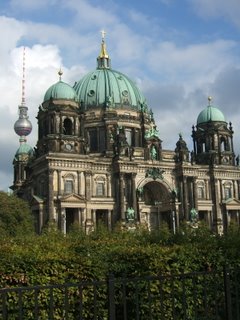 On my way to the grocery store today, I saw my breath, for the first time since I've been here. This made me reflect on the passage of time and, then, on how I haven't written anything in my blog for a while.
On my way to the grocery store today, I saw my breath, for the first time since I've been here. This made me reflect on the passage of time and, then, on how I haven't written anything in my blog for a while.So, Berlin. In general we felt like we were in Chicago for most of the time that we were in Berlin. Of course the comparison is not complete; Berlin didn't invent the skyscraper, and Chicago wasn't Hitler's vision of the capital of a new continent. But at least superficially, it works for us. There's a similar mix of modern and old buildings, similar scale of both city and the buildings therein, and similar commercial history. And they're both flat cities with parks and well-preserved sight lines to interesting buildings.
The photo I chose for today is of the Berliner Dom, a cathedral on the eastern side of the city. It was built around the turn of the century and then almost immediately hit by bombs in WWII, and it took until 1993 -- after German reunification -- to finish restoration.
Behind the church on the left is the TV tower built in the late 60s by the (communist) GDR. The pink splotches are remnants of the World Cup (held throughout Germany this summer); the sphere was decorated to look like a pink soccer ball.
This was our last day in Berlin. We rented bikes and went around the city and through Tiergarten. "Tier" means "animal," and it is right next to the zoo, but Tiergarten itself is a huge wooded park in the center of the city. It felt more like a state park in the US than like a city park, except that you'd occasionally cross a bridge that had some cool sculptures at each end, or some monument in a clearing.
The day after we left was the anniversary of reunification. We saw the city well on its way getting ready for the holiday, closing off streets and setting up for festivals.
